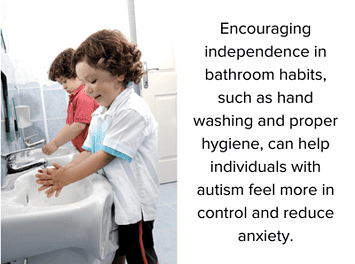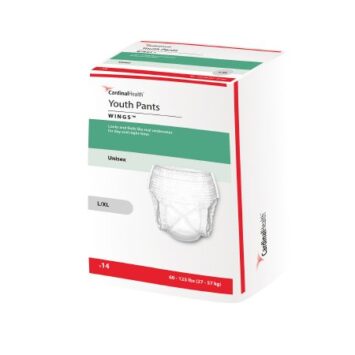Autism and incontinence do not necessarily go hand in hand. However, incontinence is a common challenge among individuals with autism that can significantly impact their quality of life. Although the prevalence of incontinence among individuals with autism is high, according to the National Institutes of Health, it is often overlooked or dismissed as a behavioral issue rather than a medical concern. Understanding the link between autism and incontinence is crucial for developing effective strategies for managing this issue.
In this blog post, we will explore the factors that may contribute to incontinence in individuals with autism, common signs and symptoms, and strategies for managing this issue. We will also discuss the importance of supporting individuals with autism and incontinence.
What is Autism?
First, let’s familiarize ourselves with what autism is before we talk about how incontinence can become an issue for those diagnosed with this disorder. Autism, or Autism Spectrum Disorder (ASD), is a neurodevelopmental disorder that affects communication, social interaction, and behavior. It is a “spectrum” disorder because its symptoms can vary widely in severity and how they present themselves.
People with autism may struggle with social interaction, communication, and repetitive behaviors. Symptoms usually appear before age three and can persist throughout the person’s life. There is no known cure for autism, but early diagnosis and intervention can help improve outcomes and quality of life for individuals with the disorder. The exact cause of autism is still unknown, but it is believed to involve a combination of genetic and environmental factors, according to Medical News Today.
The Link Between Autism and Incontinence
Several factors can contribute to incontinence in individuals with autism. Identifying and addressing these is essential to develop effective strategies for managing autism and urinary incontinence.
Some contributing factors include:
Sensory processing difficulties: Many individuals with autism have sensory processing difficulties, which can make them more sensitive to certain textures, sounds, and smells. This can lead to avoiding certain bathroom routines, such as using the toilet, wiping, or washing hands, which can increase the likelihood of accidents.
Communication challenges: Communication difficulties are a common feature of autism, and individuals with the disorder may struggle to express their needs and preferences regarding using the toilet. It can make it challenging for caregivers to identify when they need to use the restroom.
Bathroom habits: Some individuals with autism may develop bathroom habits that make them more prone to accidents, such as avoiding using the toilet or holding in urine for extended periods.
Anxiety and stress: Many individuals with autism experience high levels of anxiety and stress, which can lead to physical symptoms such as increased heart rate, sweating, and a sense of urgency to urinate. There can be a connection between autism and frequent urination.
Medical conditions: Certain medical conditions, such as urinary tract infections, constipation, or bowel or bladder problems, can increase the likelihood of incontinence in individuals with autism.
Signs and Symptoms of Incontinence in Those with Autism
Here are some common signs and symptoms of incontinence in individuals with autism:
 Bedwetting: Many children with autism experience bedwetting, even after the age when it is considered normal. Bedwetting can indicate an underlying medical condition or a behavioral issue.
Bedwetting: Many children with autism experience bedwetting, even after the age when it is considered normal. Bedwetting can indicate an underlying medical condition or a behavioral issue.
Daytime accidents: Individuals with autism may experience bladder and bowel accidents during the day. Various factors, including communication difficulties, sensory processing difficulties, or bathroom habits, can cause this.
Frequent urination: Some individuals with autism may need to urinate frequently throughout the day. Autism and frequent urination can indicate an overactive bladder or possibly a urinary tract infection.
Constipation: Hard, infrequent bowel movements can put pressure on the bladder and cause leaking or accidents.
Avoiding the restroom: Avoiding using the restroom altogether can lead to accidents and urinary tract infections, which may be related to sensory processing difficulties, anxiety, or bathroom habits.
It is important to note that incontinence is not a behavioral issue but a medical concern that can significantly impact the quality of life of individuals with autism. If these signs or symptoms are present, talking to a healthcare professional to identify the underlying cause and develop an appropriate treatment plan is essential.
Strategies for Managing Autism and Incontinence
Here are some strategies for managing autism and urinary incontinence:
Develop a consistent bathroom routine: Individuals with autism may benefit from a consistent bathroom routine that includes scheduled restroom breaks throughout the day. This process can help establish a predictable pattern and reduce anxiety.
Address sensory processing difficulties: Since individuals with autism may have sensory processing difficulties that make bathroom routines challenging, identifying and addressing these difficulties, such as using preferred textures or smells for toileting supplies, can make the experience more comfortable and reduce the likelihood of accidents.
Address communication challenges: Try providing alternative communication methods, such as using a communication device or visual aids like the ones on Do2Learn’s website, to help facilitate effective communication.
Address underlying medical conditions: Identifying and addressing underlying medical conditions like a urinary tract infection or constipation can help improve continence.
Promote independence: Encouraging independence in bathroom habits, such as hand washing and proper hygiene, can help individuals with autism feel more in control and reduce anxiety.
Provide positive reinforcement: Praise or rewards for successful bathroom routines and habits can help encourage and motivate individuals with autism to maintain continence.

Working with healthcare professionals and caregivers is essential to develop an individualized plan for managing incontinence in individuals with autism. This plan may be a combination of these strategies or additional interventions, including the use of incontinence products, based on the individual’s specific needs and challenges.
Supporting Individuals with Autism and Incontinence
Supporting individuals with autism and incontinence is essential for several reasons. First and foremost, incontinence can significantly impact an individual’s quality of life, causing embarrassment, social isolation, and decreased participation in daily activities, which can hurt their physical and emotional health and overall well-being.
Supporting individuals with autism and incontinence also involves promoting inclusivity and acceptance. Incontinence is a medical concern, not a behavioral issue, and individuals with autism should not be stigmatized or shamed for their incontinence. Instead, the focus should be on providing them with appropriate support and resources to manage their incontinence safely, respectfully, and dignifiedly.
Our hope at Personally Delivered is to help provide appropriate support and resources so that we can help individuals with autism manage incontinence, feel more in control of their daily routines, and lead more fulfilling lives.
Best-Selling Incontinence Products
Disclaimer: Important Notice Regarding Medical Advice
The information provided in this blog is intended for general informational purposes only and should not be considered a substitute for professional medical advice, diagnosis, or treatment.





